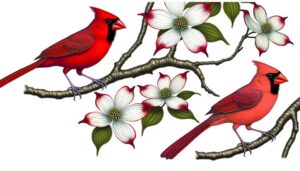When Do Baby Cardinals Turn Red? A Growth Timeline
Baby cardinals, also known as fledglings, begin to grow their distinctive red feathers within their first year, primarily after their first molt. The shift from their initially drab brown and grey plumage to bright red signifies their development and progress.
It is essential to mention that cardinal color change, beyond age, is influenced significantly by diet and sun exposure, with a more varied carotenoid diet resulting in more vivid plumage. By exploring further, you would acquire a deeper understanding of nature’s exquisite plan through the examination of a cardinal’s color transformation.
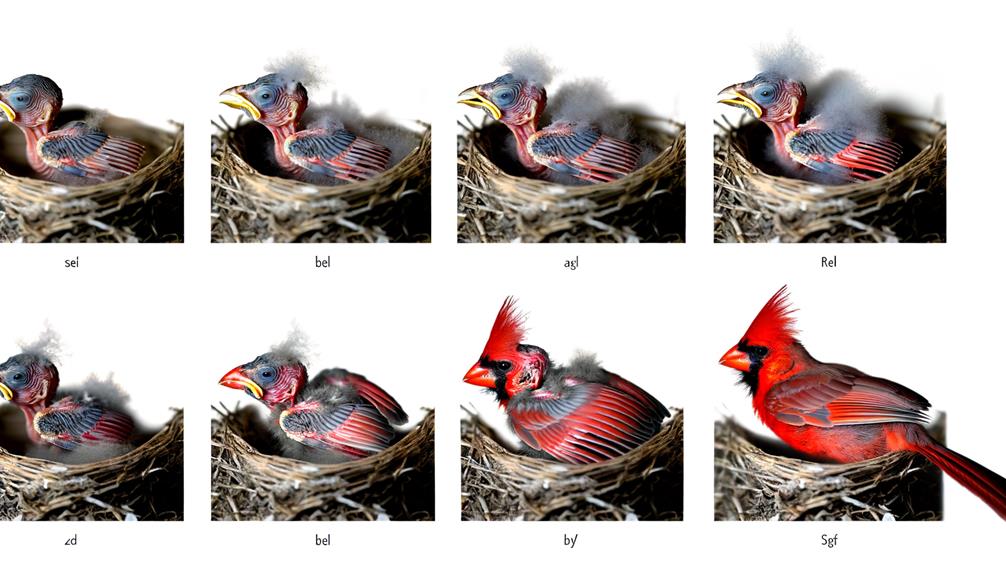
Key Takeaways
- Baby Cardinals, also known as fledglings, start to turn red after their first molt, which occurs in their first year of life.
- The transformation from dull brown to vibrant red is gradual and signifies the bird’s growth and maturity.
- Factors such as diet, age, and sunlight exposure influence the coloration of Cardinals, with a richer carotenoid diet leading to brighter feathers.
- Male Cardinals typically exhibit a more vibrant red coloration than females, who retain a subdued brown and grey palette with hints of red.
- Observing this color change in the wild is easier as the bright red plumage of male Cardinals notably stands out against green foliage.
Baby Cardinals’ Feather Development
| Growth Stage | Description |
|---|---|
| Hatchling (0-10 days) | Baby cardinals are born without feathers, completely dependent on parents for warmth and food. |
| Nestling (10-14 days) | Feathers begin to develop, but they are grayish-brown, offering camouflage from predators. |
| Juvenile (3-4 weeks) | Juvenile cardinals have brown and tan plumage with light streaks; no red feathers are present yet. |
| Sub-adult (2-4 months) | Male cardinals begin to develop red feathers, while females retain a brownish color with red tinges. |
| Adult (12 months) | Males are fully red by their first year, while females exhibit a muted reddish-brown plumage. |
Understanding Cardinal Bird Species
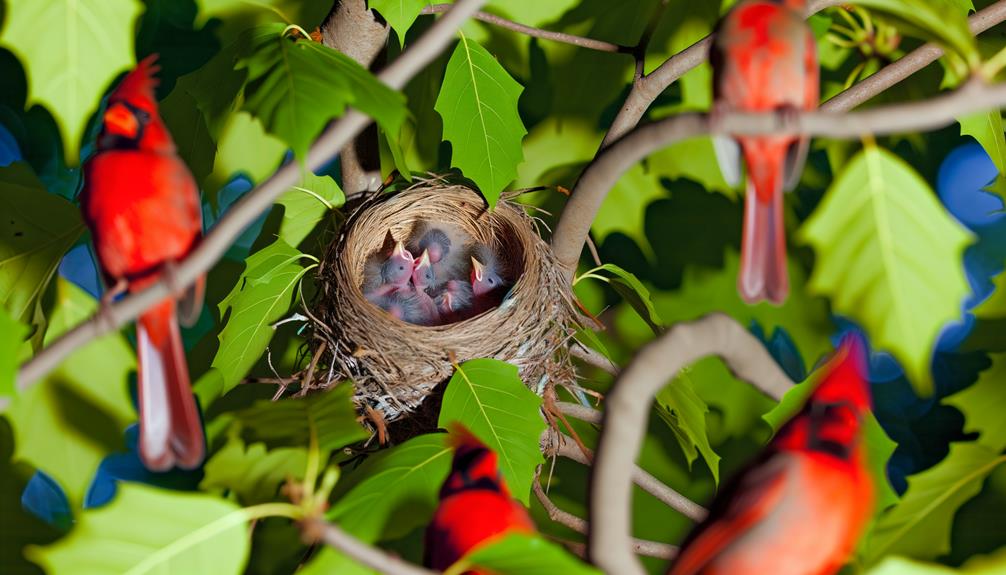
While you may be familiar with the vibrant red plumage of the adult male Cardinal, it’s important to understand that this bird species, scientifically known as Cardinalis cardinalis, exhibits sexual dimorphism, meaning males and females have distinct appearances.
Unlike their male counterparts, female Cardinals have a more subdued color palette, primarily consisting of shades of brown and grey, with some reddish hues on their wings, crest, and tail. This color differentiation plays a significant role in their mating rituals, where males impress females with their bold colors.
The juveniles, irrespective of their gender, resemble the females until they mature. Understanding this unique color transformation is essential in deciphering the age and gender of Cardinals.
Enjoy this freedom to explore the intriguing world of Cardinals, beyond their eye-catching red.
The Life Cycle of Baby Cardinals
Now, as you delve deeper into the enchanting world of Cardinals, it’s time to shed light on the life cycle of their fledglings.
Cardinals, scientifically known as Cardinalis, usually lay two to five eggs per clutch. These eggs hatch within 11 to 13 days, after a meticulous incubation period by the mother.
Once hatched, these helpless nestlings are dependent on their parents for food and protection. They fledge, or develop flight feathers, within 9 to 11 days post-hatching.
However, fledglings aren’t ready to leave their parents just yet. You’ll find them under parental care for another month, learning essential survival skills.
Then, they’re free to pursue their journey, signifying the completion of the cardinal fledgling life cycle. This fascinating cycle is an embodiment of freedom, a confirmation to the resilience of nature.
Color Transformation in Cardinals
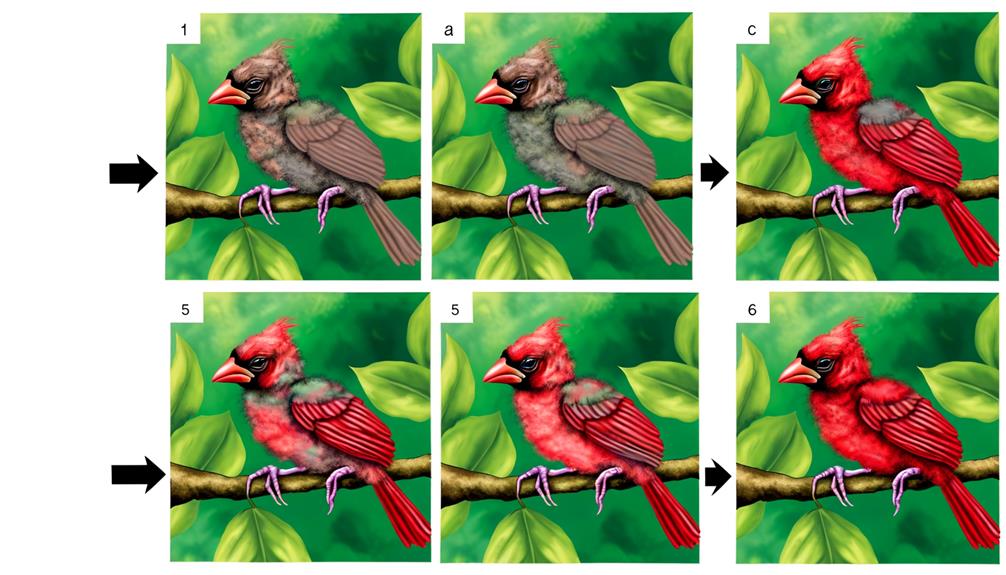
Delving into the color transformation of Cardinals, understanding that these birds don’t hatch with their iconic red plumage is essential. When they’re born, you’ll see them covered in a mix of grey and brown feathers. This muted coloration helps them blend into their nests, offering a natural defense against predators.
Their transformation to vibrant red isn’t immediate. As the juvenile cardinals mature, they undergo a molting process. This is when the old, dull feathers fall out, and new, brightly colored ones grow in their place.
For male cardinals, this is when they develop their signature red coloration. You’ll typically see this change in their first year. However, females remain a more subdued shade, sticking to a palette of browns and grays with hints of red.
Factors Influencing Cardinal Coloration
Several factors can influence the coloration of Cardinals, including diet, age, and exposure to sunlight. The pigments found in their food, particularly carotenoids, are essential in developing their vibrant color. Cardinals can’t produce these pigments; they must consume them.
So, the richer the diet in carotenoids, the brighter their feathers. Age is another significant factor. Young Cardinals are typically dull and brownish, with males starting to turn red after their first molt, usually around 120 days old.
Observing Cardinal’s Plumage Change
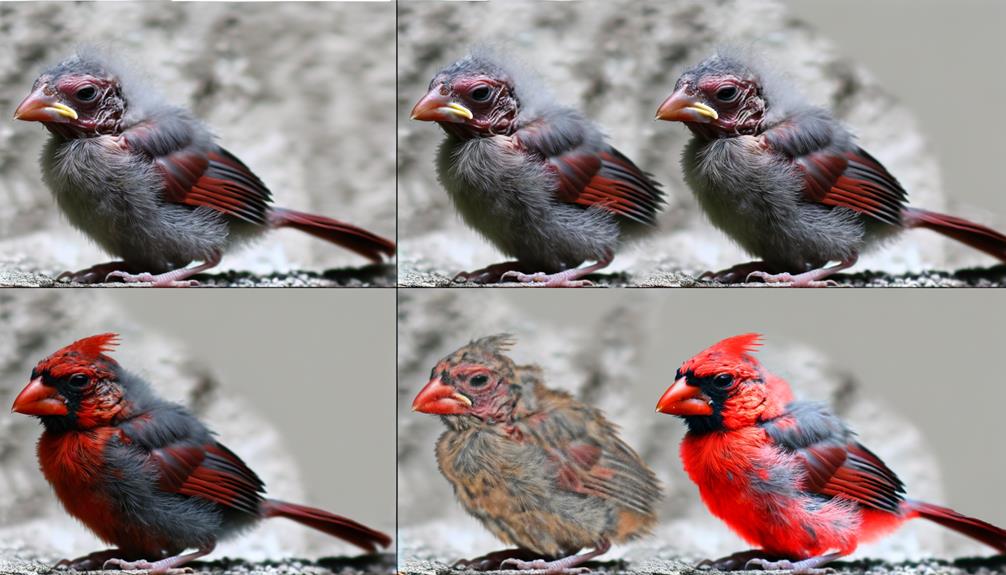
Watching a Cardinal’s plumage shift from a dull brown to a vibrant red is an intriguing process influenced by several natural factors. You’ll notice the gradual change as the young bird matures, yet it’s not an overnight transformation.
As you observe, picture these scenarios:
- A young Cardinal, its feathers a simple brown, camouflaged in the underbrush
- Over time, the brown begins to fade, touched by the hues of red
- The bird’s feathers, once dull, now shimmer with a vibrant crimson
- Finally, the Cardinal stands out, its bright red plumage a stark contrast against the green foliage
This metamorphosis is part of nature’s grand design; it’s a symbol of growth and maturity.
Impact of Diet on Cardinal Redness
You might be surprised to learn how much a cardinal’s diet influences its vibrant red color.
As cardinals mature, the intensity of their redness can often be linked to specific nutrient intake.
It’s important to understand how dietary changes can affect this striking hue, which serves as a maturity marker in these birds.
Influence of Nutrient Intake
In the field of avian biology, it’s fascinating to note that a cardinal’s diet plays a significant role in determining the intensity of its red plumage. Their vibrant hue is a result of an intake of certain nutrients, primarily carotenoids found in their food.
- Seeds, fruits, and insects are cardinal’s primary food sources, rich in carotenoids.
- Higher carotenoid intake leads to brighter redness.
- Low carotenoid intake can result in duller, less vibrant plumage.
- A well-nourished cardinal is likely to display a more dazzling shade of red.
Therefore, the food a cardinal consumes greatly influences its plumage color.
Remember, it’s not just about quantity, but also the quality of nutrients, that impacts a cardinal’s redness.
Redness: A Maturity Marker
Expanding on the connection between diet and plumage color, it’s important to note that the cardinal’s red hue also acts as a clear indicator of maturity. When observing cardinals, you’ll see that young ones are drab brown, while adult males flaunt vibrant red feathers.
This isn’t just a surface alteration. The red color actually signifies a cardinal’s capability to locate and consume a diet abundant in carotenoids, plant pigments that produce red hues. In essence, the redder the cardinal, the higher the quality of its diet. This not only makes them visually appealing but also signals robust health.
For these birds, red plumage isn’t about vanity, but rather a symbol of survival. Therefore, when you come across a red cardinal next time, you’re truly witnessing a demonstration of its dietary success and maturity.
Dietary Change Effects
Exploring dietary habits can greatly change the color intensity of a cardinal’s plumage. Mainly, the redness is a result of pigments, known as carotenoids, found in their diet.
Let’s dig deeper into this:
- Carotenoids are ingested mainly from fruits and insects.
- A diet abundant in these pigments can lead to a more vibrant red hue.
- Conversely, a shortage of carotenoids in a cardinal’s diet may result in less colorful feathers.
- Therefore, the dietary intake directly affects the vibrancy of a cardinal’s coloration.
Conclusion
You’ve journeyed through understanding the cardinal species, their life cycle, color transformation, and the factors influencing their coloration.
You’ve observed the plumage change and realized the impact diet has on their redness.
Now you know, baby cardinals turn red usually around their first molt, typically before they’re a year old.
It’s an intricate, fascinating process that highlights the beauty of nature.
So, the next time you spot a cardinal, you’ll appreciate its vibrant red hue even more.




